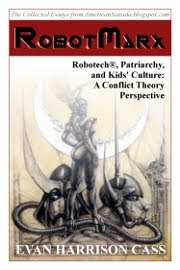 Midwest Comic Book Association
Midwest Comic Book Association knows how to celebrate. This past Saturday and Sunday, MCBA and volunteers played generous hosts to a gamut of comix fans, creators and vendors alike at the 24th annual
SpringCon in Saint Paul, Minnesota. Despite
severe weather, fun appeared to be had by all. I know
I had a great time.
As a guest creator, I premiered -- and sold out of (!) --
my ROBOT MARX book. (Always in-stock and available for purchase
online, BTW.) It was a real pleasure to chat with fellow fans and other interested individuals about
ROBOTECH, sociological theories, and the publishing process. It was also a real pleasure to visit with my tablemates,
Jennifer "Inkbunny Diaries" Young and her husband
Jason "Straight Line Stitch" White. We talked about life, religion and family between lulls, and managed the table for one another when the other was away. (Jenny's books are available
here; learn about Jason's band
here.)


In addition to connecting with Jenny and Jason, it was a treat to reconnect with a few other old friends too. Friend-of-
a-friend and fellow Central Wisconsin native,
Robb Wadzinski was my first customer; the last time we saw each other was at Wizard World Chicago 2008... now he's married. Old-school ROBOTECH fan and someone I indirectly dedicated ROBOT MARX to (
"AX Robotech Fans, Class of 2006"),
Chad "Marshall" VanVorst was busy masquerading as Darth Vader with con attraction
Star Wars' 501st Legion - Central Garrison, but managed to swing by my table -- in and out of costume -- to chat regularly; we geeked out about our favorite cult cartoon (naturally) and made plans to meet up for a drink at the next MCBA show. And what would a MCBA show be without good ol'
Michael "MetroMed" Hutchison? I met "The Hutch" at WWC08, found out he used to live in my hometown (Wausau, WI) in the '90s, and
hosted him as a guest-of-honor in 2009 at the comix/sci-fi convention I used to organize. Mike's one of the nicest guys in the industry with a sincere, endearing love for the superhero genre and superhero comix; even though we're polar opposites in many ways, visiting with him is always a joy. (His book is available to preview and buy
here.)
As a fan, I had three objectives: Buy
Ryan Kelly's FUNRAMA #2 preview-zine. Meet
Noah Van Sciver and buy an issue of BLAMMO. And meet
Trina Robbins and ask her to autograph my ROBOTECH: ART 2 hardcover.


Between freelance work and parenting,
Ryan Kelly has been slowly-but-surely rolling out his creator-owned FUNRAMA PRESENTS comix series. It's always inspiring to see creators dedicated to their own ideas, so I was quick to
purchase Issue One ("The Mutant Punks") last year.
Issue Two ("Raccoon") is still in-progress, but
Kelly did prepare an eight-page "MN SpringCon Preview" zine for the show. I thoroughly enjoyed the peek, and look forward to reading the full issue whenever it becomes available.

I recently became intrigued with
Noah Van Sciver and his work following
a series of podcast interviews. Between his public front (self-deprecating), his comix ideology ('80s/'90s indie) and his stories (Juggalo love; Joseph Smith bio; kooky chickens), I knew I had to meet him. It took me forever to find his table, but when I finally did... well, Noah is awesome. We shared our run-ins with and admiration for Harvey Pekar; we compared experiences growing up in religious-minority low-income families; and Noah showed me stunning original art pages from his in-progress "Young Abraham Lincoln" masterwork,
THE HYPO. I ended up walking away with signed copies of BLAMMO
Number Six and
Seven, and I promptly poured myself into them. BLAMMO is now my favorite floppy. If you're a comix enthusiast and haven't already, do yourself a favor and
buy them. Van Sciver is a talent to watch.

And then there was
Trina Robbins. It was a genuine honor to meet and talk with one of comix foremost historians, creators and trailblazers.
And contemporary paper-doll creators. In 1987, Robbins contributed four paper-doll compositions to
ROBOTECH: ART 2. In 1987, my father bought said book for me as a gift; I've regularly perused its contents ever since. Trina was kind enough to autograph all four selections
and her bio/photo in the back. (She was also thrilled to hear my story about how I made my dad photocopy her ART 2 paper-doll pages so I could cut out and play with them as an 11 year-old boy... ROBOTECH is wonderfully subversive that way.) Meeting Robbins provided me a meaningful way to connect both my
guest and
fan SpringCon 2011 experiences.
As mentioned at the outset, SpringCon's organizers are
generous -- hearty grab bags and fun attractions for attendees, free tables and full catering for creators, and affordable space and an open mind for a variety of dealers. Without a doubt, MCBA went out of their way to make it a "Comic Book Celebration." I'm already anticipating their
FallCon in October...























 *
*
 **
**



















